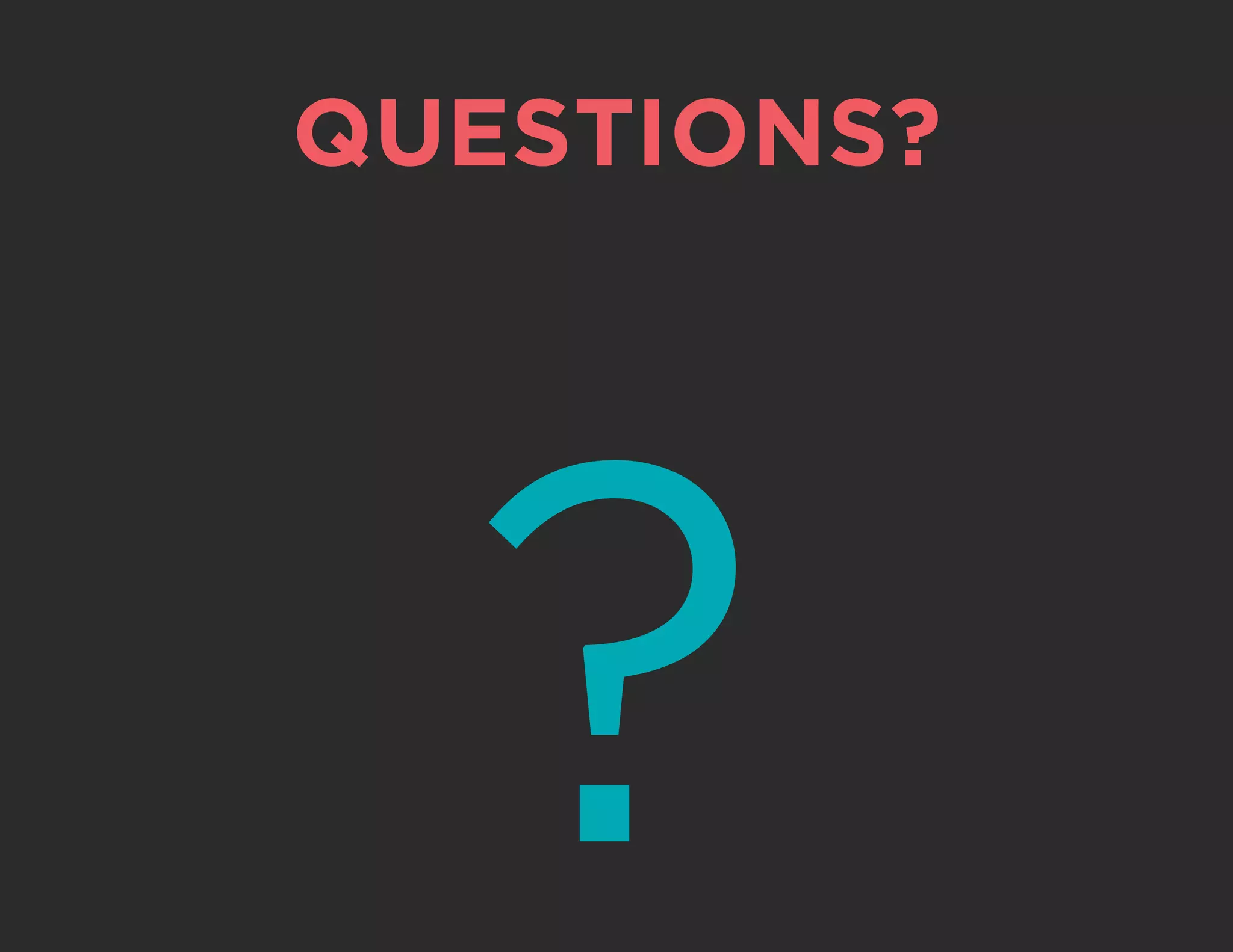This document provides an introduction to JavaScript arrays, objects, and methods. It explains that arrays can hold ordered lists of values of any type and that their length property reports the size. Objects store collections of properties and methods, and values can be accessed and updated using dot or bracket notation. Methods are functions associated with objects that can affect or return values. Loops like for can be used to iterate through arrays and arrays of objects. The this keyword refers to the owner of a method. Examples are provided for creating, accessing, and updating arrays and objects and using methods within objects.


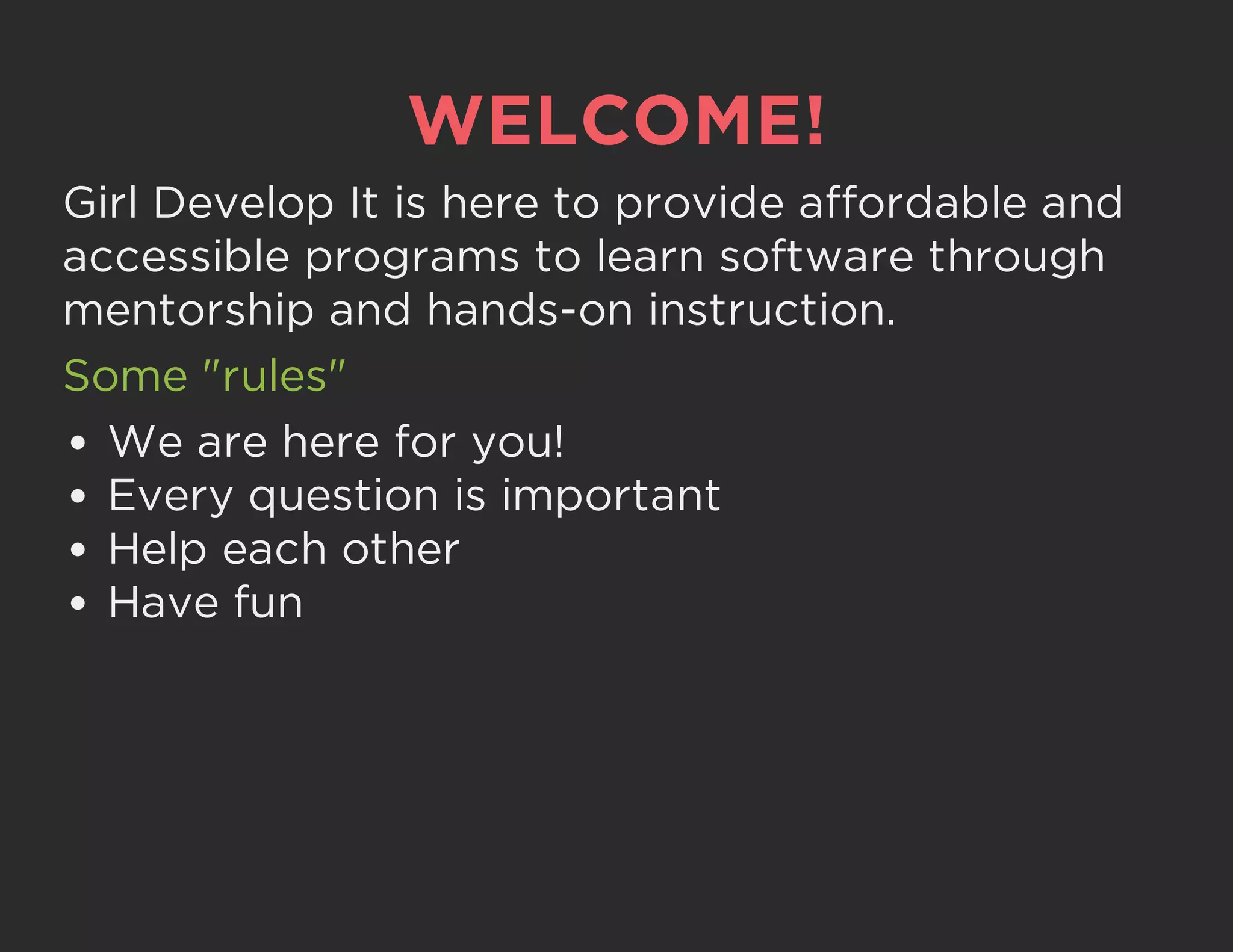
![ARRAY An array is a data-type that holds an ordered list of values, of any type: The length property reports the size of the array: var arrayName = [element0, element1, ...]; var rainbowColors = ['Red', 'Orange', 'Yellow', 'Green', 'Blue', 'Indigo', 'Violet']; var favoriteNumbers = [16, 27, 88]; var luckyThings = ['Rainbows', 7, 'Horseshoes']; console.log(rainbowColors.length);](https://image.slidesharecdn.com/javascriptclass2-130911191532-phpapp02/75/GDI-Seattle-Intro-to-JavaScript-Class-2-4-2048.jpg)
![ARRAYS -- RETURNING VALUES You can access items with "bracket notation". The number inside the brackets is called an "index" Arrays in JavaScript are "zero-indexed", which means we start counting from zero. var arrayItem = arrayName[indexNum]; var rainbowColors = ['Red', 'Orange', 'Yellow', 'Green', 'Blue', 'Indigo', 'Violet']; var firstColor = rainbowColors[0]; var lastColor = rainbowColors[6];](https://image.slidesharecdn.com/javascriptclass2-130911191532-phpapp02/75/GDI-Seattle-Intro-to-JavaScript-Class-2-5-2048.jpg)
![ARRAYS -- UPDATING VALUES You can also use bracket notation to change the item in an array: Or to add to an array: You can also use the push method (recommended): var awesomeAnimals = ['Corgis', 'Otters', 'Octopi']; awesomeAnimals[0] = 'Bunnies'; awesomeAnimals[4] = 'Corgis'; awesomeAnimals.push('Ocelots');](https://image.slidesharecdn.com/javascriptclass2-130911191532-phpapp02/75/GDI-Seattle-Intro-to-JavaScript-Class-2-6-2048.jpg)
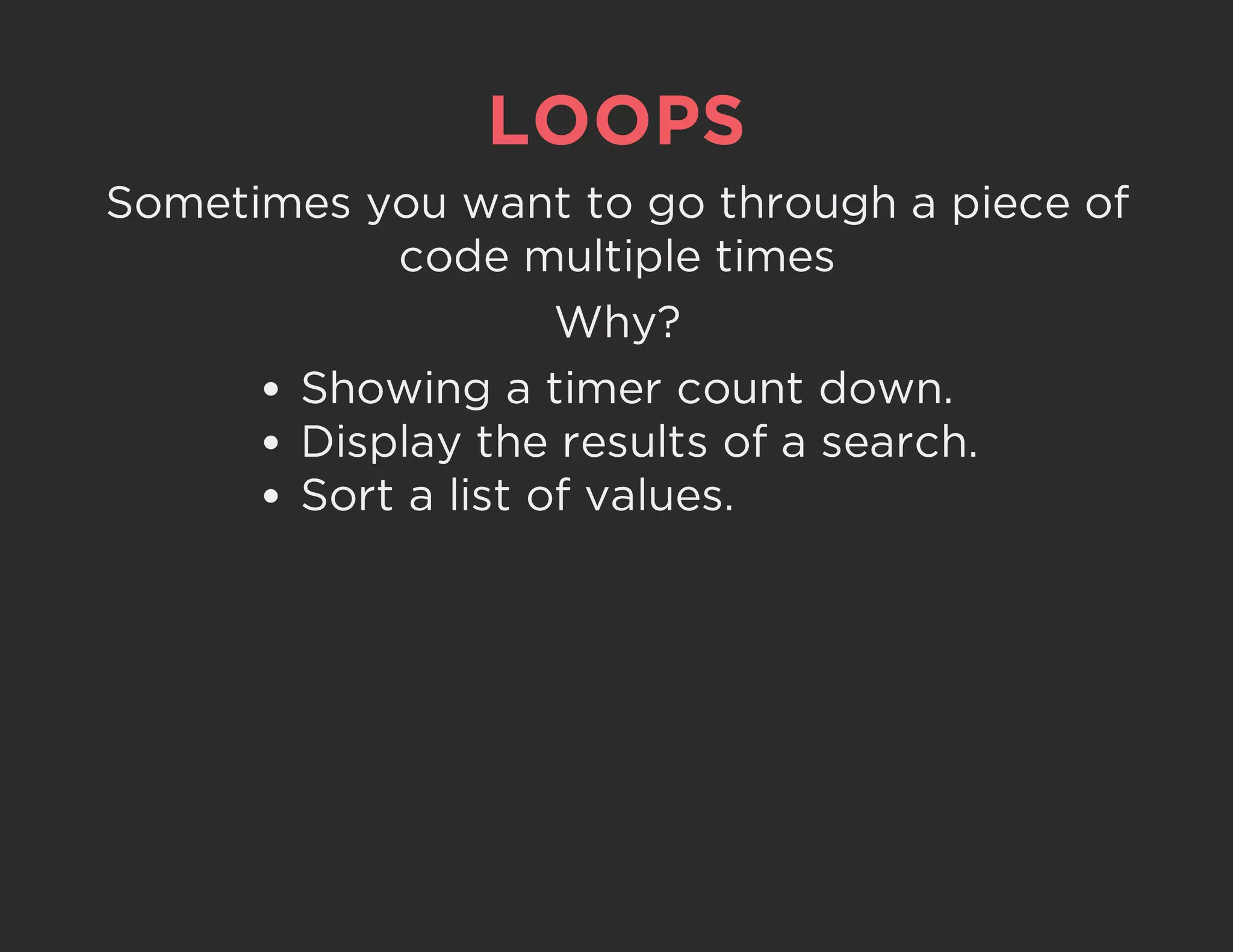
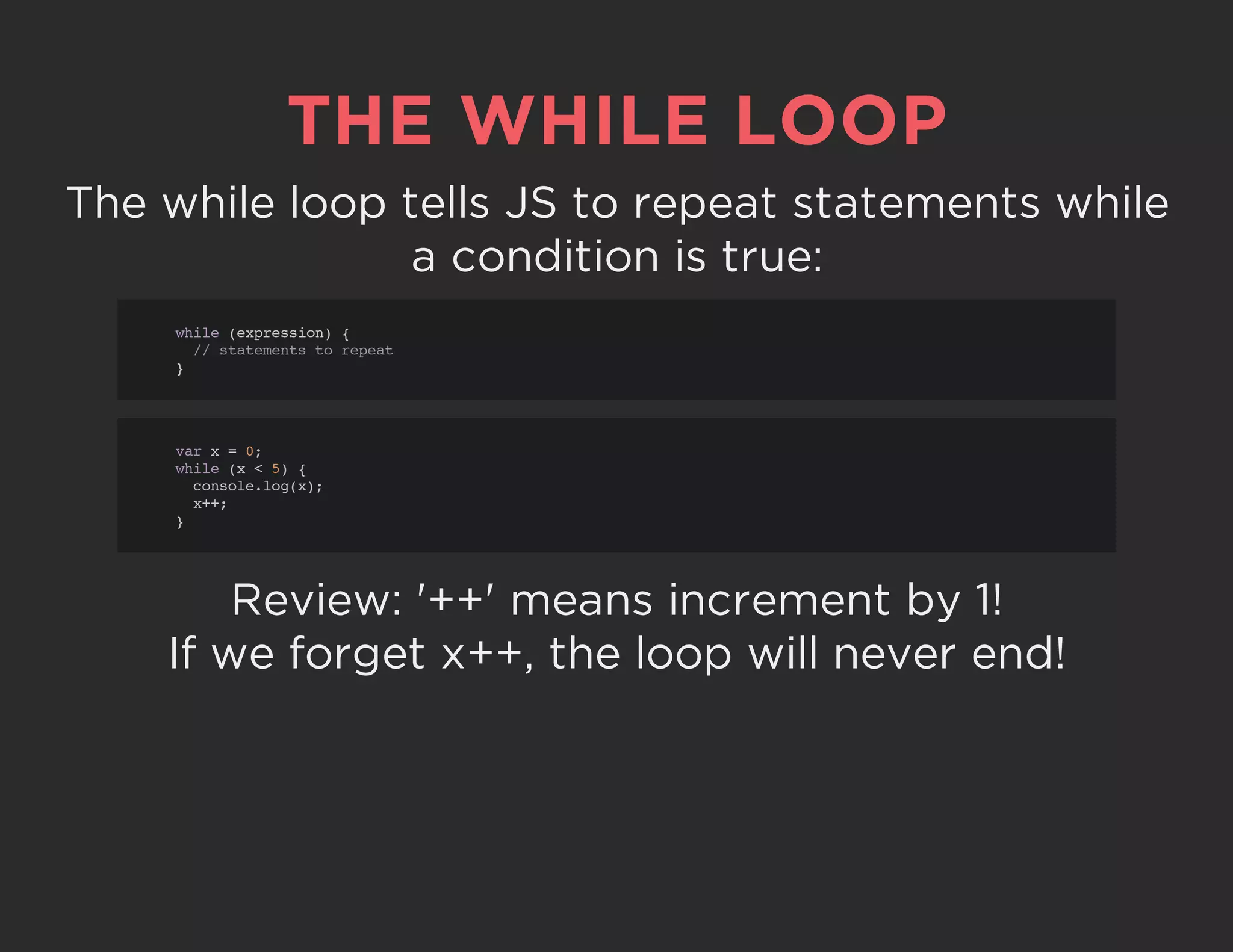
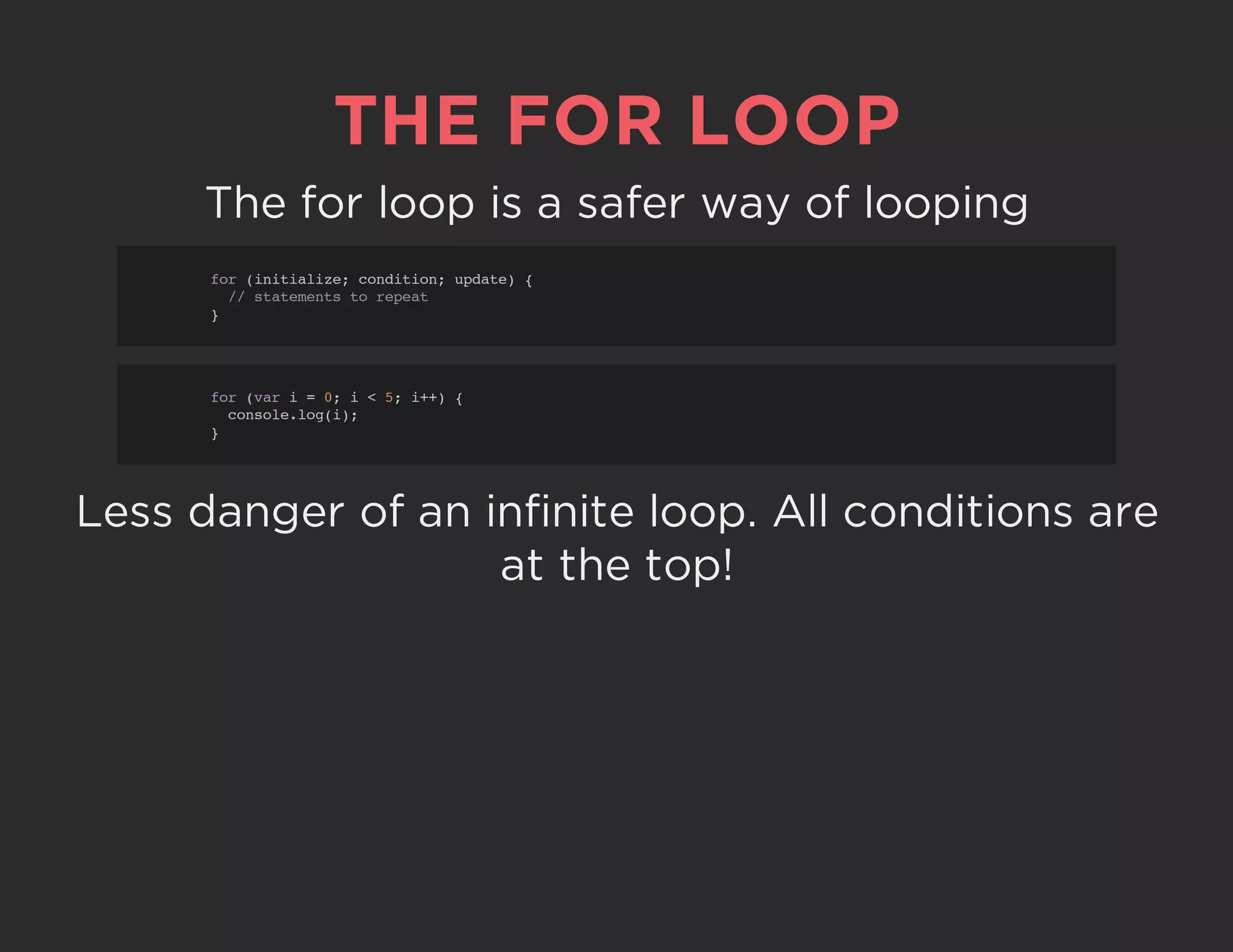
![LOOPS AND ARRAYS Use a for loop to easily look at each item in an array: var rainbowColors = ['Red', 'Orange', 'Yellow', 'Green', 'Blue', 'Indigo', 'Violet']; for (var i = 0; i < rainbowColors.length; i++) { console.log(rainbowColors[i]); }](https://image.slidesharecdn.com/javascriptclass2-130911191532-phpapp02/75/GDI-Seattle-Intro-to-JavaScript-Class-2-10-2048.jpg)

![LET'S ANSWER IT<button type="button" onclick="favoriteThings()"> See my favorite things</button> function favoriteThings(){ var favoriteThings = ['Rabbits', 'Orange', 'Yogurt', 'Brussel Sprouts', 'Otters']; var result = 'My favorite things are: '; for (var i = 0; i < favoriteThings.length; i++) { result += favoriteThings[i] + ', '; } document.write(result); }](https://image.slidesharecdn.com/javascriptclass2-130911191532-phpapp02/75/GDI-Seattle-Intro-to-JavaScript-Class-2-12-2048.jpg)
![LET'S ANSWER IT (BONUS)function favoriteThings(){ var favoriteThings = ['Rabbits', 'Orange', 'Yogurt', 'Brussel Sprouts', 'Otters']; var result = 'My favorite things are: '; for (var i = 0; i < favoriteThings.length; i++) { if (i < favoriteThings.length - 1) { result += favoriteThings[i] + ', '; } else { result += "and " + favoriteThings[i] + '.'; } } document.write(result); }](https://image.slidesharecdn.com/javascriptclass2-130911191532-phpapp02/75/GDI-Seattle-Intro-to-JavaScript-Class-2-13-2048.jpg)
![OBJECTS Objects are a data type that let us store a collection of properties and methods. var objectName = { propertyName: propertyValue, propertyName: propertyValue, ... }; var charlie = { age: 8, name: "Charlie Brown", likes: ["baseball", "The little red-haired girl"], pet: "Snoopy" };](https://image.slidesharecdn.com/javascriptclass2-130911191532-phpapp02/75/GDI-Seattle-Intro-to-JavaScript-Class-2-14-2048.jpg)
![OBJECTS -- RETURNING VALUES Access values of "properties" using "dot notation": var charlie = { age: 8, name: "Charlie Brown", likes: ["baseball", "The little red-haired girl"], pet: "Snoopy" }; var pet = charlie.pet;](https://image.slidesharecdn.com/javascriptclass2-130911191532-phpapp02/75/GDI-Seattle-Intro-to-JavaScript-Class-2-15-2048.jpg)
![OBJECTS -- RETURNING VALUES Or using "bracket notation" (like arrays): Non-existent properties will return undefined: var name = charlie['name']; var gender = charlie.gender](https://image.slidesharecdn.com/javascriptclass2-130911191532-phpapp02/75/GDI-Seattle-Intro-to-JavaScript-Class-2-16-2048.jpg)

![ARRAYS OF OBJECTS Arrays can hold objects too! That means we can use a for loop! var peanuts = [ {name: "Charlie Brown", pet: "Snoopy"}, {name: "Linus van Pelt", pet: "Blue Blanket"} ]; for (var i = 0; i < peanuts.length; i++) { var peanut = peanuts[i]; console.log(peanut.name + ' has a pet named ' + peanut.pet + '.'); }](https://image.slidesharecdn.com/javascriptclass2-130911191532-phpapp02/75/GDI-Seattle-Intro-to-JavaScript-Class-2-18-2048.jpg)
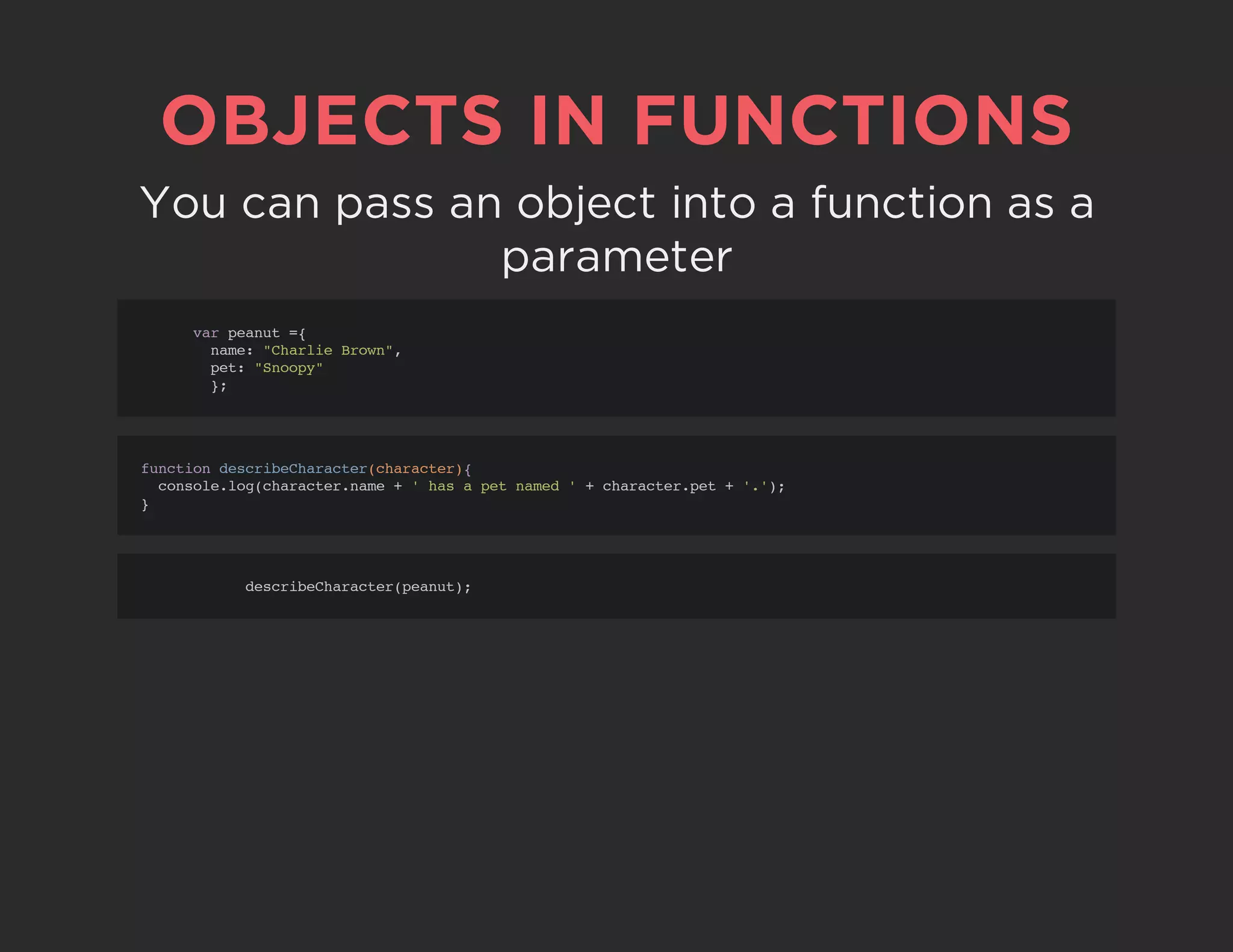
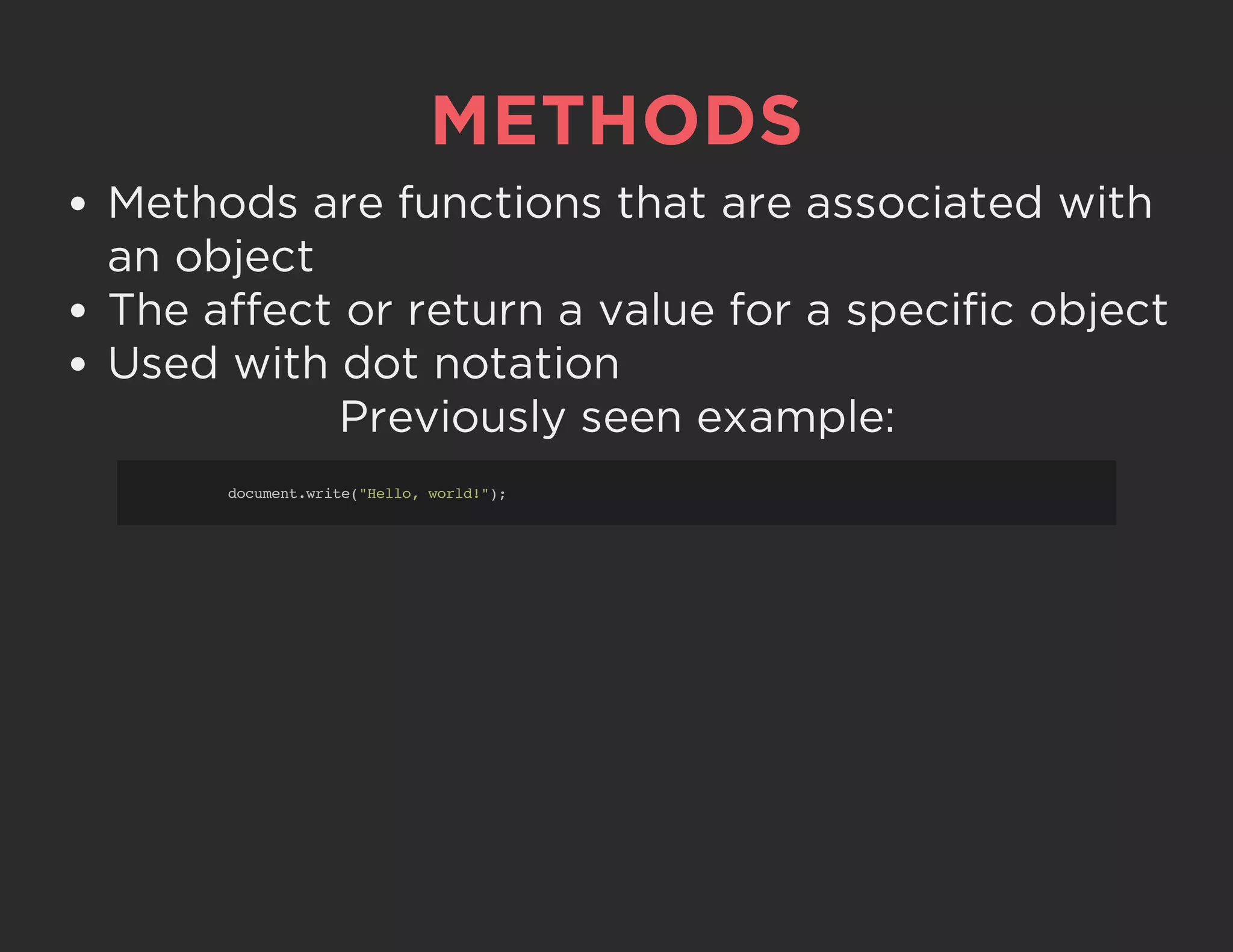

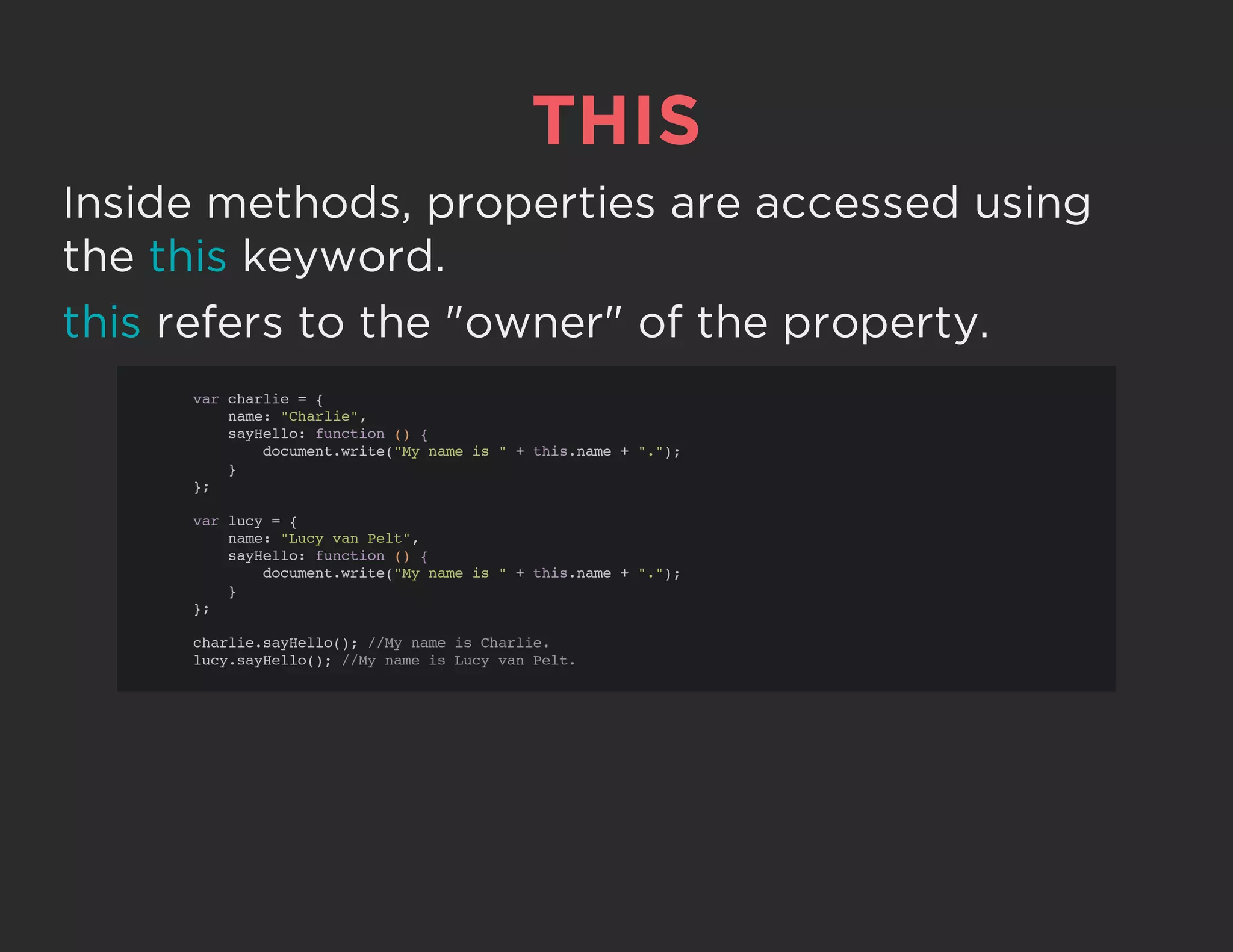
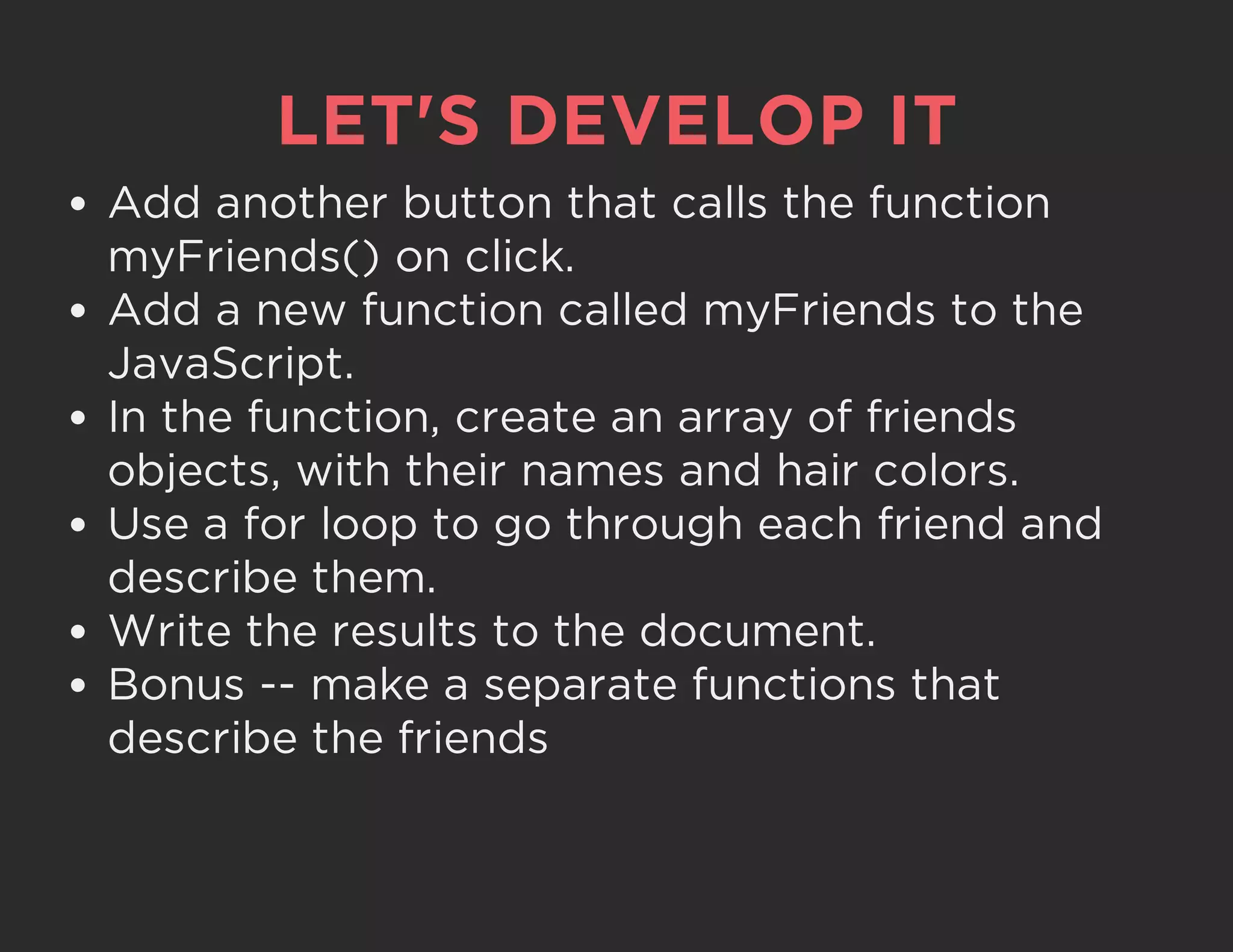
![LET'S ANSWER IT<button href = "#" onclick="myFriends()">My friends</button> function myFriends(){ var friends = [ {name: 'Santa Claus', hair: 'red'}, {name: 'Easter Bunny', hair: 'brown'}, {name: 'Tooth Fairy', hair: 'blue'} ]; var results = "My friends: " for(var i = 0; i < friends.length; i++){ document.write("My friend " + friend[i].name + " has " + friend[i].hair + " hair. "); } }](https://image.slidesharecdn.com/javascriptclass2-130911191532-phpapp02/75/GDI-Seattle-Intro-to-JavaScript-Class-2-24-2048.jpg)
![LET'S ANSWER IT (BONUS)function myFriends(){ var friends = [ {name: 'Santa Claus', hair: 'red'}, {name: 'Easter Bunny', hair: 'brown'}, {name: 'Tooth Fairy', hair: 'blue'} ]; var results = "My friends: " for(var i = 0; i < friends.length; i++){ results += describeFriend(friends[i]); } document.write(results) } function describeFriend(friend){ return "My friend " + friend.name + " has " + friend.hair + " hair. "; }](https://image.slidesharecdn.com/javascriptclass2-130911191532-phpapp02/75/GDI-Seattle-Intro-to-JavaScript-Class-2-25-2048.jpg)
